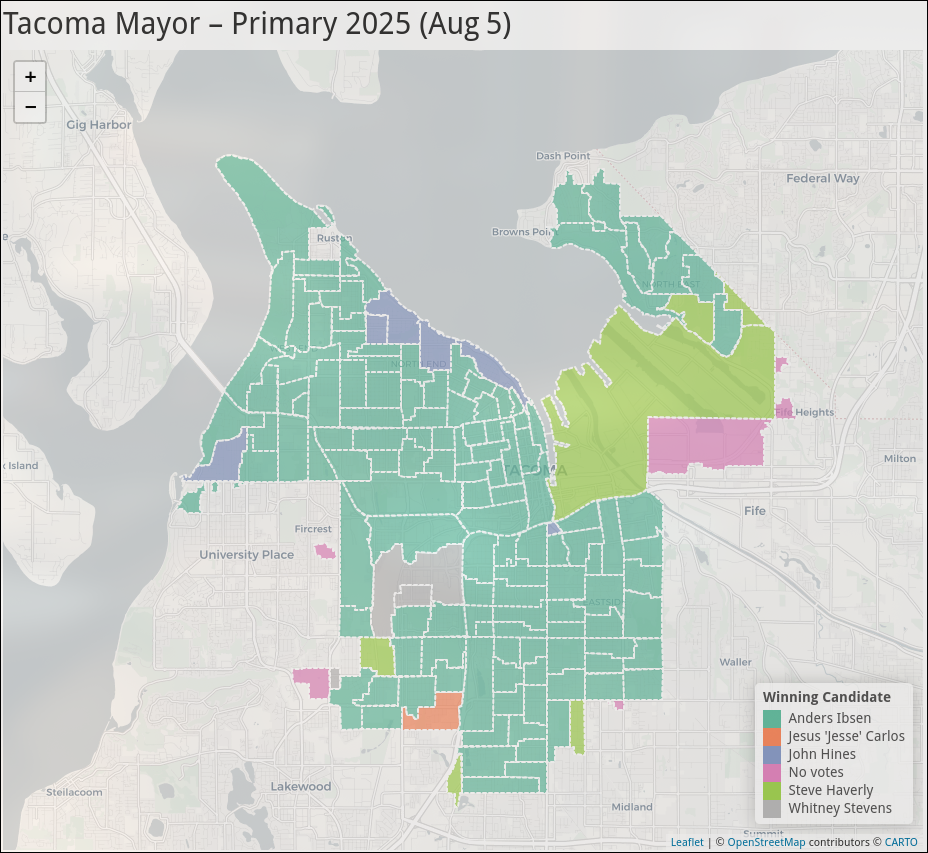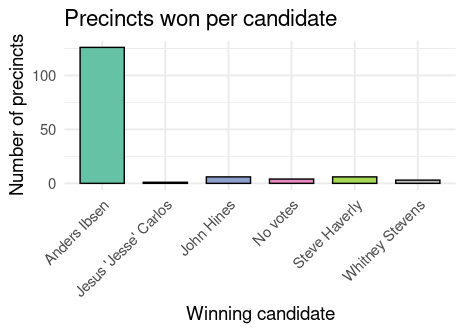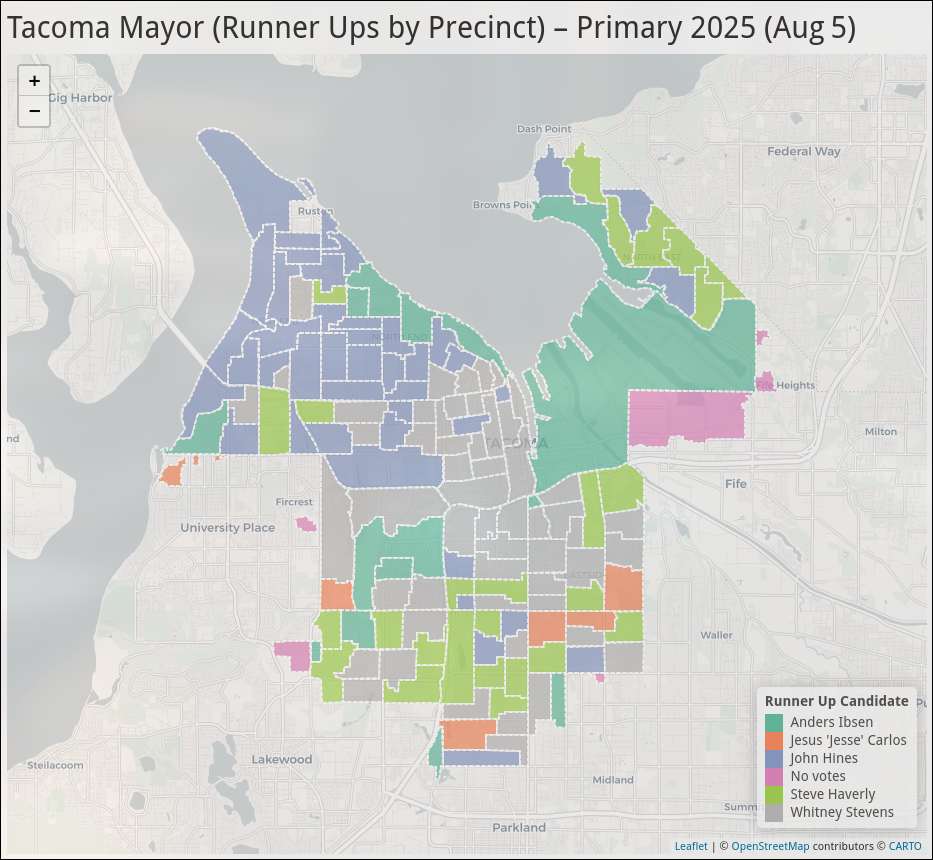A clean sweep for Ibsen in Tacoma Mayor's Race
In a stunning sweep, Anders Ibsen had the most votes of those running in 130 precincts of 152 analyzed in the City of Tacoma. The next best candidates to were Steve Haverly and John Hines with 6 precincts each, Whitney Stevens with 3 precincts, and Jesus ‘Jesse’ Carlos with 1 precinct.

The Election as a Geographic Test
Every election is a test of the sentiments of the public. Do they seek to change or to stay the course? Are the people hungry for new leadership? Are they satisfied with public services and infrastructure, the economy? And where are these sentiments the strongest or the weakest throughout a geography? It’s difficult to answer these questions, and damned near impossible without actual data.
When initial returns from elections come in from the County Auditor’s office in charge of running elections, they are flat totals. We know when votes came in and when and in what districts, but when it comes to something like the Mayor’s race in Tacoma, having a single number doesn’t tell you very much about geography, doesn’t tell you very much about the breakout of demography of voters, their average age, their general income level, etc. So when the precinct data comes out, things get a bit more interesting.
Why Precinct‑Level Maps Matter
A precinct‑level view lets us see the “where” behind the numbers. It reveals neighborhoods that are solidly behind a candidate, the pockets where a challenger is gaining ground, and the overlaps that could decide a runoff.

The 2025 Tacoma Citywide Races
On August 5, 2025 Tacoma voters went to the polls for two citywide contests: the race for mayor and the at‑large council seat 6.
Mayor’s Race – Candidates and Context
For the mayor’s race, we had five candidates: Anders Ibsen, a former twice‑elected City Councilmember from District 1 on Tacoma’s West Side, John Hines, the current Tacoma Councilmember representing District 1, Whitney Stevens, who serves as the Chair of the 27th Legislative District Democrats organization, Steve Haverly, who has run for mayor before, Jesus ‘Jesse’ Carlos and Anthony ‘Tony’ Ginn.
First‑Place Wins: Who Led the Most Precincts?
In a stunning sweep, Anders Ibsen had the most votes of those running in 130 precincts of 152 analyzed in the City of Tacoma. The next best candidates to were Steve Haverly and John Hines with 6 precincts each, Whitney Stevens with 3 precincts, and Jesus ‘Jesse’ Carlos with 1 precinct.
Ibsen won in Northeast Tacoma, the Eastside, South End, North End, West End, Central Tacoma, and South Tacoma. John Hines lead in precincts with waterfront views in Old Town and north of N. 30th Street and in one precinct narrowly near Titlow Park. Whitney Stevens lead in several precincts near Tacoma Mall.


The Importance of Second‑Place Results
If trends hold, as they likely are this far out after votes have been counted, Ibsen and Hines will continue on to the general election, but one thing that should not be lost is that the voters who voted for other candidates should not be discounted as they, in many precincts, were more numerous than the top two candidates. Since there is less variability in the first‑place results, one thing I want to look at is the second‑place results.
These data show strength in Whitney Stevens’ campaign in the North Slope and south of 6th Avenue throughout Central Tacoma, the Lincoln District, and East Tacoma and a scattering of precincts throughout Tacoma south of Interstate 5. Steve Haverly placed second in much of Northeast Tacoma, and the South End in the vicinity of 56th Street. John Hines placed second in much of his own Council District on the West Side and was able to take second place in areas near Proctor and West of Pine Street.

Interpreting the Landscape
What does this mean? What paths to victory do the candidates have?
For Ibsen, the likely path is to retain his existing voter base across the city and to enlist the support of Whitney Stevens, who may be ideologically more in line with Ibsen’s progressive stances on housing and public investments (outside of police and fire) than Councilmember Hines. Stevens did well in complementary geographies to where Ibsen did (Central Tacoma and South of I-5) and would bolster vote tallies.
For John Hines, the task is a much steeper climb as his base of support needs to be rebuilt within District 1 and his relatively poor showing south of Interstate 5 means he will need to find a way to connect with the diverse and working‑class voters of Legislative District 29. A candidate that he may consider courting the support of is Steve Haverly, who came in second in NE Tacoma and much of the South End in the area of S 56th Street.
My next look at this race will examine demographic data as we get additional voter information to understand exactly who voted.
Looking Ahead: Demographics, Turnout, and Strategy
When the precinct‑level demographic layers become available—age brackets, household income, ethnicity, homeowner versus renter status—we’ll be able to answer questions like:
- Which neighborhoods are most responsive to housing‑affordability messaging?
- Where does turnout lag, and how might that be improved for a runoff?
- Are there under‑served communities whose preferences are hidden in the current data set?
A deeper dive will help each campaign sharpen its outreach and help voters see where their issues fit into the broader city picture.
Methodology
Data for this analysis was acquired from the Pierce County Auditor’s Website (https://www.piercecountywa.gov/328/Elections ) and was analyzed with R, leaflet, and Shiny R packages. The workflow involved:
- Downloading the precinct‑level CSV files.
- Cleaning and normalizing vote totals for each candidate.
- Joining the results to a shapefile of Tacoma precinct boundaries.
- Rendering interactive maps with the
leafletpackage 🇺🇦 for quick visual checks.
Final Thoughts
Geography is the silent storyteller in every election. By turning raw precinct numbers into maps, we can see not only who won, but why they won in particular neighborhoods, and where the next battlegrounds will emerge. As the 2025 Tacoma mayoral race moves toward a runoff, the maps above will help the public keep a clear view of the city’s political terrain.
Stay tuned for the next post, where we’ll layer in age, income, and ethnicity data to complete the picture.
